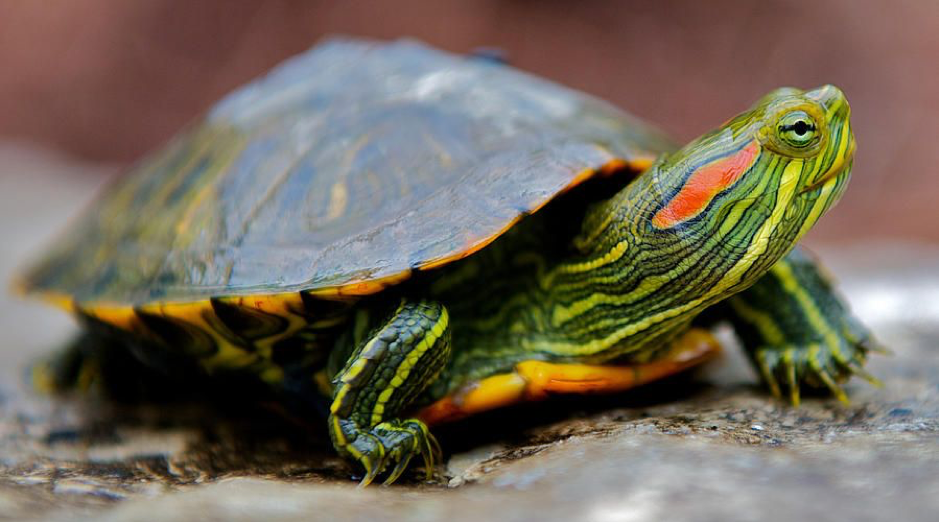
Red Eared Slider Caresheet
Introduction
The Red Eared Slider (Trachemys scripta elegans) is probably the most commonly kept turtle across the world. However, they are now classed as an invasive species in the European Union and cannot be sold as pets. Never the less there are still plenty being kept as pets across Europe. Red Eated sliders are easily recognosed by the red pattern on the side of their head. They can live up to around 30 years old and grow up to 12 inches long with females getting larger than males. The Red-Eared slider’s native range is from the south-central to the south-east of the United States. They can be found inhabiting slow-moving streams, rivers, lakes, creeks, ponds and marshes, and can often be seen basking on logs and rocks or at the edge of a river bank.

Red-Eared Slider Turtle Photo
Habitat and Housing
Hatchling Red-Eared Sliders can be kept in a 2/3 foot long aquarium. Adults however will require a much larger aquarium or ideally a pond. The water depth should be at least twice the width of the turtle’s shell. The water temperature should range between 22-26 degrees Celsius. This can be achieved using an aquarium heater. An underwater hiding place should be provided where the turtle can hide but cannot become trapped and drown.
A basking area is crucial, where the turtle can leave the water completely and fully dry off. The basking area’s temperature should be between 30-35 degrees Celsius. This can be provided by fitting a heat lamp to your aquarium. Red-Eared Sliders require UVB lighting to survive. UVB provides the turtle with vitamin D3 which then enables the turtle to absorb Calcium from its food. Without Vitamin D3 the turtle will develop metabolic bone disease (MBD) and eventually die. This can be provided by using bulbs which emit UVB which are readily available from any pet shop.
Water quality is very important as the turtles can develop health issues due to inadequate water quality. One way to help ensure good water quality is by using an aquarium or pond filter. External filters are generally more suitable than internal filters as they are larger, and the turtle cannot dislodge the filter causing it to malfunction. Aquatic turtles produce huge amounts of waste in comparison to fish, so you should pick a filter which is rated for at least double the water volume of your enclosure. Frequent water changes are also necessary to ensure good water quality. Artificial plants, stones and logs should be added to the enclosure to create a more natural look and feel.
Feeding and Diet
Red-Eared Sliders are omnivorous, so it is important to provide them with both plant and animal matter. Good foods include; fish, worms, insects, leafy greens such as dandelion and aquatic plants such as water hyacinth, water lettuce or duckweed. Furthermore, there is a wide variety of commercial turtle foods available. Hatchling Red-Eared Sliders require higher levels of protein and calcium in their diet then adults. As Red-Eared sliders get older their diet should consist of more plant matter. So, it is important to choose the food which has been formulated to provide optimum nutrition for your turtle’s growth stage. There are a number of vitamins and minerals which are crucial to ensure your turtles healthy development and wellbeing, so it is important to choose a turtle food with a wide range of Vitamins and minerals or add them using a multivitamin and calcium supplement.
It is important not to overfeed your turtle as it will have health implications. Overfeeding in turtles has been shown to cause liver problems, shell deformation and shortened lifespan. Hatchlings should be fed every 2nd day while adults should be fed approximately two times every week.
Red-Eared Slider Turtle Health
- Poor water quality can result in your turtle developing skin, shell, and ear infections. Ear infections commonly show up as large bumps behind your turtle's eyes and need to be addressed by your vet.
- Swollen eyes can occur due to a lack of vitamin A in the turtle’s diet. The eyes appear pink and swollen. There are eye drops available but in severe cases a vet should be consulted. The best way to prevent this problem is to provide your turtle with the appropriate diet.
- Metabolic bone disease (MBD) will occur if your turtle isn’t receiving sufficient levels of vitamin D3 and calcium. This will lead to shell deformation, limpness, decreased appetite and if left untreated eventually death. A vet should be consulted if you think your turtle is suffering from MBD.
- Shell Rot can occur if your turtle doesn’t have access to an adequate basking area where it can fully dry off. It causes the shell to literally rot away over time. If left untreated shell rot will gradually get worse. If you think your turtle has shell rot contact your veterinarian.
Sexing and Breeding
Red-Eared Sliders are sexually dimorphic meaning males and females possess different characteristics other than their sexual organs. Male Red-Eared Sliders are generally smaller than females and have much longer front claws. Also, their tails are longer than the females. Finally, positioning of the cloaca on a male painted turtle is further down the tail then on a female.
Red-Eared Sliders begin mating from spring upon emerging from hibernation. The courtship begins when the male and female come face-to-face. The male will stroke the females face and neck with his elongated front claws. The female will then return the gesture. The female will lay her eggs between late May and mid-July. Clutch size varies depending on a number of factors. Larger females will lay larger clutches. Red-Eared sliders can lay up to 30 eggs in one clutch.
References and Further reading
Austins Turtle Page. Red-Eared Slider Available at: http://www.austinsturtlepage.com/Care/caresheet-red_ear_slider.htm [Accessed 24/07/2019].
Erst, C.H. (2009) Turtles of the United States and Canada. 2nd edition: The Johnsons Hopkins University Press.
Kirkpatrick, D. T. (2006) Aquatic Turtles. 1st Edition: T.F.H Publications.
Vin MA, Red-Eared Sliders. Available at: http://www.reptilesmagazine.com/Red-Eared-Slider-Care-Sheet/ [Accessed 24/07/2019].
